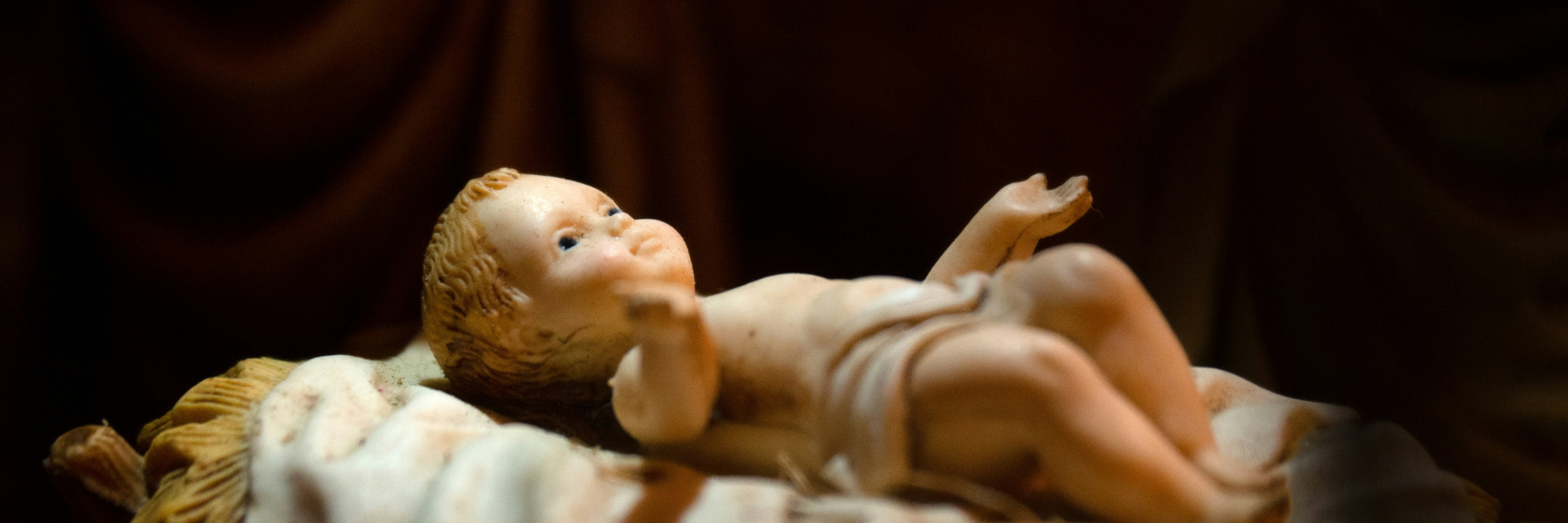
Every December, as we kneel before the manger and gaze upon the Infant Christ, we are reminded of a mystery so astounding that even the angels bow in wonder: God became Man.
God did not merely appear as human, He did not just put on a human “mask,” rather He took on a real, living, vulnerable human body. And for those of us trying to live a life of holistic health, Christmas shines a light on something essential: our bodies matter profoundly.

The Body Is Not an Afterthought
From the beginning, Scripture proclaims that our bodies are part of God’s good design. When God formed Adam from the dust of the earth and breathed life into him, He declared not only Adam’s soul but his entire embodied existence “very good.”
Yet Christmas takes this truth even further. In the Incarnation, the eternal Son of God unites Himself forever with our humanity, embracing the limits, needs, and experiences of bodily life.
He grew in Mary’s womb. He was born into the cold and light of a Bethlehem night. He knew hunger, tiredness, touch, warmth, and pain.
God does not shy away from the body. He enters it.
If the Incarnation teaches us anything, it is that the body is not merely a shell but a sacramental reality, through it God reveals Himself to us and redeems us. Jesus healed through human touch, preached with His human voice, and ultimately saved us through the offering of His Body on the Cross.
This truth has everything to do with the way we approach fitness, movement, and wellness. When we stretch, breathe deeply, strengthen weak muscles, or care for our physical needs with intention, we honor the God who took on flesh. Caring for the body is not vanity; it can be an act of stewardship and gratitude.
In a culture that often reduces the body to an ornament or a project, Christmas whispers a far more beautiful truth: your body has dignity because God Himself took one. This speaks into our struggles with body image, fatigue, injury, disability, aging, and the ongoing work of forming healthy habits.
Fitness for Catholics is never just about appearance—it’s about living fully the life God gave us, strengthening the body so that it can serve, love, pray, and participate in God’s mission with joy.
It’s also why Pietra Fitness grounds physical strengthening and stretching in prayer and virtue, reminding us that movement can serve the soul as well as the body.
Living the Incarnation Through Fitness and Wellness
So how might we honor the sacredness of the body this season?
- Move with gratitude—exercise not as punishment, but as praise.
- Rest intentionally, remembering that Christ embraced the vulnerability of sleep.
- Nourish your body as a gift entrusted to you, not a problem to fix.
- Honor the bodies of others through patience, gentleness, and charity.
- Receive the sacraments, where God continues to work through matter, including the matter of your own body.
- Contemplate the Christ Child, whose tiny, dependent body reveals that God dwells most easily in humble, cared-for places.
This Christmas, as you celebrate the Word made flesh, remember: God came not simply to redeem your soul but your whole embodied life.
The manger is God’s declaration that your body matters, and caring for it can be a holy act.
The Incarnation and the Body: What Christmas Teaches Us About the Sacredness of Our Physical Being
Every December, as we kneel before the manger and gaze upon the Infant Christ, we are reminded of a mystery so astounding that even the angels bow in wonder.


“Blessed are those persecuted for righteousness’ sake, for the Kingdom of Heaven is theirs”—Mt 5:10
Maggie the Good Mom
Maggie was a good mom. Little Johnny was starting to master addition. Her Kate was getting the hang of spelling compound words like shopkeeper. They were so cute in their bedtime prayers, always remembering Grandma and their cousins. And while they weren’t perfect, they were developing a genuine love and respect for people.
As Maggie pulled into the parking lot at the playground, she caught sight of Sally—another mom—and her smile faded before returning as an embarrassed grin. As she got out, she could hear Sally clucking her tongue and saying: “Ah, get ready girls. Here comes Miss High and Holy. Who is she fooling? She acts so prim and perfect. Is she really wearing that sweater? Why can’t she be more like us?”
Delusional or Divine?
When Jesus teaches, “Blessed are the persecuted…” we can think He’s being delusional. Of course, persecution isn’t a blessing! We are made for communion, not rejection and ridicule. Is this a lie from the pits of hell?
Well, it is either that or a consoling bit of divine revelation. Let’s break it down and see, ok?
“Do not be conformed to this world, but be transformed by the renewal of your mind.” —Rm 12:1
Righteousness’ Sake
Righteousness means fidelity to God—specifically, fidelity to the mission God has entrusted to us: to make Christ known, to build up disciples, and to be a prophetic witness in a world that often either denies Christ or confesses Him with their lips while denying Him by their lives.
This mission begins at home with our spouse and children, then extends to family, friends, work, school, and every other dimension of our lives. We are the salt of the earth. We are the light of the world. A light is not brought in to be put under a bed or a basket, but on a stand to give light to the whole house.
This is our mission—for righteousness’ sake.
“Go therefore, and make disciples...” —Mt 28:19
Persecution
In a perfect world, sharing Christ with others would be met with joy and adulation. We don’t live in that world. Here, sharing Christ often leads to rejection and ridicule.
Jesus Himself prophesies that His coming will lead to division—two against three and three against two. We are not isolated because we have a community of believers, but there are clear lines of demarcation. Our communion is not universal.
This division causes pain. What good can come from it?
“All things work for the good of those who love God.” —Rm 8:28
The Kingdom of Heaven
The Kingdom of Heaven is Christ Himself—belonging to God through Him. Persecution becomes a doorway to special intimacy with our Lord, who was Himself rejected and ridiculed: His own kinsmen believed Him to be “out of his mind.” The Apostles fled from Him in the Garden. The rulers of His people accused Him of casting out demons by the prince of demons, and later stirred up the same crowd who cried, “Hosanna to the Son of David!” to shout even louder, “Crucify Him!”
“I consider everything a loss because of the surpassing worth of knowing Christ Jesus my Lord, for whose sake I have lost all things.” —Phil 3:8
Transforming Union
Union with Christ is transforming—from the limits of human nature to the unbounded glory of divinity. One part and one path for this transformation is the pain of persecution.
We can only get so far along the spiritual path by doing good—like water heated to 211°. At that temperature, water is very hot, but mostly useless. But something happens at 212°. The “persecution” of the heat turns the water into steam. It becomes a force capable of powering a train, a cargo ship, or even a whole city.
At 212°, water becomes the Light of the World.
“When I am weak, then I am strong.” —2 Cor 12:10
The “Revenge” of Maggie the Supermom
Maggie hated herself for the thoughts she had about Sally. She had already confessed them. A month after the playground incident, Sally slipped on some ice and broke her arm.
“Serves her right,” was Maggie’s first thought, and she knew it was wrong.
That night during prayers, little Johnny prayed for Sally to get well soon. Maggie knew it was God speaking to her through her son. How could she be happy at Sally’s suffering?
The next morning, during her personal prayer, she came across Lk 6:27–28:
“I say to you who are listening:
Love your enemies.
Do good to those who hate you.
Bless those who curse you.
Pray for those who calumniate you.”
Maggie prayed, “Oh Lord, grant me the grace to love Sally, to do good to her, to bless and pray for her.”
That afternoon, Maggie made an extra lasagna and brought it to Sally’s with a note:
Sally,
I’m so sorry you broke your arm. Here is a small token of my love for you. I pray that God may fill you and your family with His strength and consolation during this time. You are a natural-born leader with so much to offer our community. May God grant you the grace to be a great leader and great mom.
In Christ with love,
Maggie
From persecution, Maggie had passed to prophetic witness. Through union with Christ, she had been transformed from a limited “good mom” to a divine “supermom.”
Mother Teresa’s “Anyway” Poem*
People are often unreasonable, illogical, and self-centered;
Forgive them anyway.
If you are kind, people may accuse you of selfish, ulterior motives;
Be kind anyway.
If you are successful, you will win some false friends and some true enemies;
Succeed anyway.
If you are honest and frank, people may cheat you;
Be honest and frank anyway.
What you spend years building, someone could destroy overnight;
Build anyway.
If you find serenity and happiness, they may be jealous;
Be happy anyway.
The good you do today, people will often forget tomorrow;
Do good anyway.
Give the world the best you have, and it may never be enough;
Give the world the best you’ve got anyway.
You see, in the final analysis, it is between you and your God;
It was never between you and them anyway.
If you are someone who does well with worksheets and journal pages, try the Persecution to Prophetic Witness Worksheet
* This poem is often associated with St. Mother Teresa, though some say its actual author is Kent Keith. We share it here for its inspiring message, which resonates with her example of faith and service.
The Blessing No One Wants: From Persecution to Prophetic Witness
Maggie was a good mom. Little Johnny was starting to master addition. Her Kate was getting the hang of spelling compound words like...

As the days grow shorter and the nights longer, the Church invites us into the quiet beauty of Advent — a season of hopeful waiting and joyful preparation for the coming of Christ.
Each Sunday, we gather around the Advent wreath, lighting candles whose colors and glow tell the story of our faith: a story of promise, repentance, joy, and love.

The Advent Wreath: A Circle of Hope
The circular shape of the Advent wreath reminds us of God’s eternal love. without beginning or end. Traditionally made of evergreen branches, the wreath symbolizes everlasting life in Christ, even in the midst of winter’s barrenness. Each candle lit in the weeks leading up to Christmas draws us closer to the radiant light of Christ, born into the darkness of the world.
The Advent wreath holds four candles — three purple and one rose — each representing one week of Advent. Some families also include a fifth white candle, the Christ Candle, lit on Christmas Day to celebrate the birth of our Savior.
First Candle: The Prophecy Candle (Hope)
The first purple candle, lit on the First Sunday of Advent, symbolizes hope. It reminds us of the prophet Isaiah who foretold the coming of the Messiah. This candle calls us to place our trust in God’s promises and to look forward to the day when Christ will come again in glory.
“The people who walked in darkness have seen a great light.” — Isaiah 9:2
Second Candle: The Bethlehem Candle (Faith)
The second purple candle represents faith and is often called the Bethlehem Candle, recalling Mary and Joseph’s journey to Bethlehem. It reminds us to prepare our hearts for Christ, trusting in God’s plan even when the road feels uncertain.
“Therefore the Lord himself will give you this sign: the virgin shall conceive and bear a son, and shall name him Emmanuel.” — Isaiah 7:14
Third Candle: The Shepherd’s Candle (Joy)
The rose candle, lit on the Third Sunday of Advent (Gaudete Sunday), represents joy. The word Gaudete means “rejoice” — a reminder that our waiting is almost over. While the color purple in the Catholic liturgy symbolizes repentance, this week’s pink hue breaks through the solemnness with the bright anticipation of Christ’s coming.
“Rejoice in the Lord always; again I will say, Rejoice.” — Philippians 4:4
Fourth Candle: The Angel’s Candle (Peace)
The final purple candle symbolizes peace and is sometimes called the Angel’s Candle, reminding us of the message the angels proclaimed: “Peace on earth, good will toward men.” As we light this candle, we prepare our hearts to welcome the Prince of Peace.
“Glory to God in the highest, and on earth peace to those on whom his favor rests.” — Luke 2:14
The Christ Candle (Purity and Light)
If your wreath includes a fifth candle, the white Christ Candle is lit on Christmas Day. Its pure white color represents the sinless nature of Jesus, the true Light who came into the world to banish darkness and bring us eternal life.
“The light shines in the darkness, and the darkness has not overcome it.” — John 1:5
The Advent wreath isn’t just a decoration — it’s a prayerful way to mark time with the rhythm of the Church. Whether you light it at the dinner table, during evening prayer, or before bed, take a quiet moment each week to reflect on what each candle means for your heart and your family.
As the light of the wreath grows brighter each Sunday, may it remind us that Christ’s light is drawing near — dispelling the darkness of sin and filling our homes with the warmth of His love.
The Meaning Behind the Advent Candles and Colors
As the days grow shorter and the nights longer, the Church invites us into the quiet beauty of Advent.


If you’ve ever wondered why your energy, appetite, and motivation to work out seem to ebb and flow throughout the month, you’re not imagining it. Your menstrual cycle has a powerful influence on how you feel, move, and even how your body processes food.
By learning to sync your nutrition and exercise with your cycle, you can work with your body instead of against it—supporting hormonal balance, better energy, and overall well-being.
Let’s look at each phase and how to nourish and move your body accordingly.

Note: The day ranges listed for each phase are approximate, as every person’s cycle is different. Tracking your cycle using methods like Natural Family Planning (NFP) can help you understand your unique patterns of energy, cravings, and mood, making it easier to align your nutrition and exercise with your body’s natural rhythms.
Menstrual Phase (Days 1-5): Rest and Replenish
This is when your period begins. Hormone levels (estrogen and progesterone) are at their lowest, which can leave you feeling tired and introspective.
Nutrition Focus:
- Iron-rich foods like leafy greens, red meat, lentils, and pumpkin seeds help replenish what you lose through bleeding.
- Hydration is key! Herbal teas, soups, warm water, or bone broth can soothe cramps and bloating.
- Magnesium (found in dark chocolate, avocado, and nuts) can help ease muscle tension and mood swings.
Exercise Support:
- Gentle movement such as walking, stretching, or restorative workouts helps improve circulation and reduce cramps.
- Give yourself permission to rest if you need to—your body is doing important inner work.
The Follicular Phase (Days 6–14–approximately): Energy Rising
As your period ends, estrogen begins to rise, bringing with it renewed energy, creativity, and motivation. This is a great time to try new things or push yourself a little more in your workouts.
Nutrition Focus:
- Choose fresh, vibrant foods like fruits, veggies, and lean proteins to support growing energy levels.
- Include probiotic foods like yogurt or kefir to support gut health as estrogen increases.
- Complex carbs (quinoa, oats, sweet potatoes) provide steady fuel for more intense activity.
Exercise Support:
- Your body is primed for cardio and strength training.
- Try high-energy activities like cycling, HIIT, or dance classes.
- Enjoy the motivation and confidence that tend to peak around ovulation.
The Ovulatory Phase (Days 14-17, approximately): Peak Performance
Estrogen peaks just before ovulation, giving you a boost in stamina, strength, and mood. You may feel most social and energetic now.
Nutrition Focus:
- Light, cooling foods such as salads, smoothies, and fresh fruits can help balance your internal heat.
- Focus on anti-inflammatory foods (berries, olive oil, fatty fish) to support the body’s natural inflammatory response during ovulation.
- Stay hydrated, especially if you’re sweating more with increased workouts.
Exercise Support:
- This is your prime window for high-intensity workouts and personal bests.
- Group fitness or team sports can feel especially motivating since social energy tends to be higher.
The Luteal Phase (Days 18–28, approximately): Slow Down and Support
After ovulation, progesterone rises, preparing your body for a potential pregnancy. You may notice lower energy, increased hunger, and mood changes as PMS sets in toward the end.
- Focus on balanced meals with protein, complex carbs, and healthy fats to stabilize blood sugar.
- Vitamin B6 and magnesium (found in bananas, chickpeas, and salmon) can help with bloating and irritability.
- Dark chocolate or magnesium-rich snacks can also ease cravings naturally.
- Limit caffeine and refined sugar, which can worsen PMS symptoms.
If you’re possibly pregnant, this phase takes on an added significance. Your body is already shifting hormonally to support new life. Choose nutrient-dense foods that nourish both you and a potential baby—think leafy greens for folate, eggs for choline, and whole grains for steady energy. Stay hydrated, rest when you need to, and be gentle with yourself as your body’s needs may feel different than usual.
Exercise Support:
- Opt for low-impact workouts like Pilates, barre, or strength training at a moderate pace.
- As you near your next cycle, gentle stretching or walking may feel best.
- Focus on listening to your body’s cues rather than following a strict routine. Energy may fluctuate, and that’s perfectly normal.
By tuning in to your body’s rhythms, you can create a lifestyle that honors your natural fluctuations rather than fighting them.
Your cycle is not an inconvenience; it’s a built-in rhythm that, when understood, can help you live more harmoniously in body, mind, and spirit.
Pietra Fitness makes it easy to move with your cycle in mind. With a wide variety of classes—from restorative sessions perfect for your menstrual phase to energizing total-body workouts for your follicular or ovulatory phases—there’s something for every season of your body.
The online studio even includes prenatal and postnatal classes, supporting women through every stage of fertility, pregnancy, and beyond. Each workout integrates gentle prayer and Scripture, helping you see and honor your body as a temple of the Holy Spirit.
Nutrition and Exercise for Each Phase of your Menstrual Cycle
If you’ve ever wondered why your energy, appetite, and motivation to work out seem to ebb and flow throughout the month, you’re not imagining it.


Blessed are the peacemakers, for they shall be called sons of God.
Mae, Part One
Mae grew up on a ranch in Wyoming. She met her future husband at an FFA convention, waited faithfully for him while he completed his military service, and raised four kids with him. For 35 years she ran a restaurant serving soups, salads, sandwiches, big plates of pasta, and homemade pies.
If you had the pleasure of being invited to her home, she greeted you with a warm smile and a squishy “grandma” hug. Then she’d offer you something to eat—perhaps her locally famous cinnamon rolls—and something to drink, either sweet tea or lemonade from a large pitcher in the fridge. Then she’d sit you down, smile again, and ask her magic question: “So, what’s going on?”
The Art of Making Peace
The Hebrew word for peace is shalom. When Jesus blesses the peacemakers, He’s blessing those who make shalom.
Shalom isn’t just the result of a treaty between warring nations. It’s much more. It can mean peace, but also wholeness, rest, belonging. Perhaps the best translation for shalom is the feeling you get when you’re “home”—like Mae’s home.
A house + love = a home.
The Enemy of Shalom
There are a lot of candidates for this one: America? Modernism? Media? Social media? Posturing? A culture of activism and busyness?
I think the opposite of shalom is fear. Fear of not being loved. Fear of not being enough. Fear of not fitting in.
If you were to rise above your fear for one moment and ask, “What am I seeking?”—would you find a better answer than shalom?
“Man’s problem is that he doesn’t know how to sit quietly in his own room.” — Pascal
Finding a Balance
Mae worked. She was a tornado every morning as she got her restaurant ready and handled the rush for breakfast and lunch. She could peel a carrot faster than any human I’ve ever seen.
But she also knew how to relax—when the store was closed, when she went home to dinner with her family, on Sundays, and anytime she entertained guests.
“There is a time to work and a time to rest.” — Ecclesiastes
Nurture Shalom
The world is not going to give you shalom. The world doesn’t know shalom. The world only knows striving, bustle, and constant activity.
But Jesus keeps calling you to it—and offering it as a gift.
When He does, the world starts screaming: “You can’t do that. It’s useless. It’s worthless. You don’t want to be worthless, do you?”
Yet shalom is where you discover your worth. Will you nurture it?
Jesus’ Invitation
I, Jesus, invite you to Shalom with Me today.
There will be no agenda
except enjoying one another’s company.
Feel free to invite your friends and family—if
that would make you feel more at home, okay?
RSVP
☐ Yes ☐ No
Mae, Part Two
What was going on with Mae was sad. She was diagnosed with Stage 4 cancer in her abdomen. She spent her last days at home, surrounded by her children and grandchildren.
One night as she slept, she saw a beautiful light—more beautiful than anything she’d ever seen before. When she woke up the next day, she told her husband, Hank, “Don’t worry about me… They’re calling me home.”
After years of making shalom for others, she was finally welcomed into her Father’s house as His beloved daughter.
Blessed are the peacemakers, for they shall be called children of God.
Nurturing Peace
Mae grew up on a ranch in Wyoming. She met her future husband at an FFA convention, waited faithfully for him while he completed his military service...

When it comes to fitness, most of us celebrate the hard work—the early mornings, the tough workouts, the sweat that proves we’ve given it our all. However, progress doesn’t just come from continually pushing harder. It also comes from slowing down.
Rest days are where your body rebuilds, your energy resets, and your hard work truly pays off. Giving your body this time to recover is just as important as the effort you put into training.

Why Rest Days Matter
When you exercise, you’re actually creating small amounts of stress on your muscles, joints, and nervous system. That stress is good; it’s what challenges your body to grow stronger. But without rest, your body doesn’t have the time it needs to repair and adapt. Think of it this way: workouts break your body down, but rest days build it back up, stronger than before.
Skipping recovery can lead to overtraining (fatigue, irritability, sleep problems), higher risk of injury, and burnout or loss of motivation. On the other hand, a well-placed rest day helps prevent injuries, supports long-term consistency, and makes your next workout even more effective.
During rest, your body:
- Repairs muscles: Micro-tears from exercise are rebuilt, making muscles stronger.
- Replenishes energy: Glycogen stores are restored so you’re fueled for your next workout.
- Balances hormones: Stress hormones like cortisol decrease, while growth-promoting hormones increase.
- Strengthens the mind: Rest days improve focus and motivation, helping you approach your workouts with renewed energy.
From the very beginning, rest has been part of God’s design for us. After six days of creation, God Himself rested on the seventh day—not because He was tired, but to show us the rhythm He intended for our lives (Genesis 2:2-3). The Sabbath was made for us (Mark 2:27), reminding us that rest is not wasted time but sacred time.
When we honor rest—whether that’s a Sunday set aside for worship and family, or a recovery day between workouts—we’re acknowledging that we are not machines. We are made in the Image and Likeness of God. Rest reminds us that our strength ultimately comes from God, not from our own striving.
Make the Most of Your Rest Days
A good rest day involves making choices that actively support your body in its recovery and strength-building. Sometimes this means taking a full break, but other times it might involve gentle movements like walking or stretching.
The right choice depends on your fitness level, training intensity, and how your body feels. Listening to your body is key; fatigue, soreness, or irritability are often signs you need more recovery.
Here are a few practical tips for making the most of your rest day:
- Prioritize sleep: Nothing beats quality rest for recovery.
- Hydrate well: Water supports joint health, muscle repair, and energy balance.
- Fuel smart: Nutritious meals with protein, healthy fats, and complex carbs speed up recovery.
- Manage stress: Rest isn’t just physical—it’s mental. Reading, prayer, journaling, or simply being still can refresh your mind.
The healthiest fitness journeys aren’t built on endless training, but on balance. Rest days transform your hard work into results—stronger muscles, more energy, and a healthier mind.
Take the time to embrace recovery with the same intention you bring to your workouts and you’ll be amazed at how much further it takes you.
Recover Right: The Power of Rest Days
When it comes to fitness, most of us celebrate the hard work—the early mornings, the tough workouts, the sweat that proves we’ve given it our all.


As the days grow shorter and the air turns crisp, our bodies naturally crave warmth, nourishment, and grounding.
Fall is the perfect season to lean into healing foods that offer comfort as we move into the cooler months and also support immunity, digestion, and overall health in the seasons where illness is more prevalent.
Filling your plate with the bounty of autumn will nourish both your body and soul, helping you stay healthy and ready to do the Lord’s Will.

Pumpkin & Winter Squash
Pumpkin, butternut, acorn, and delicata squashes are packed with vitamins A and C, which help strengthen the immune system. Their high fiber content also supports digestion and helps keep blood sugar balanced. Roasted, pureed into soup, or baked into muffins, these vibrant vegetables bring both comfort and nourishment.
Apples and Pears
Is there anything more “fall” than a basket of apples? Fall fruits like apples and pears are rich in antioxidants and fiber, making them excellent for heart health and digestion.
Apples, eaten with their skin on, provide pectin—a type of fiber that feeds healthy gut bacteria. Pears offer gentle sweetness and hydration. Enjoy them fresh, baked, or stewed with cinnamon for a warming treat.
Dark Leafy Greens
While summer may be the season for salads, fall is the time to sauté kale, collard greens, and Swiss chard. These nutrient-dense vegetables are loaded with calcium, iron, and vitamin K, supporting bone and blood health.
They’re delicious sautéed with garlic and olive oil or stirred into a warm grain bowl, like this one.
Root Vegetables
Carrots, beets, turnips, and sweet potatoes thrive in the cool soil of fall and bring earthy sweetness to the table. Rich in vitamins, minerals, and antioxidants, root vegetables help boost circulation and support detoxification.
Roasting them enhances their natural sweetness, making them perfect for hearty side dishes.
Mushrooms
Mushrooms are immune-boosting powerhouses. Varieties like shiitake, maitake, and reishi have long been used in traditional medicine for their antiviral and anti-inflammatory properties. Add them to soups, stews, or sauté them for a savory addition to your meal.
Nuts and Seeds
As the weather cools, our bodies need more sustained energy. Nuts and seeds, particularly walnuts, pecans, pumpkin seeds, and sunflower seeds, provide healthy fats, protein, and minerals like zinc and magnesium. Sprinkle them over oatmeal or salads for a seasonal boost.
Bone Broth
Bone broth is one of the oldest healing foods, and for good reason. Simmering bones with vegetables, herbs, and spices releases minerals like calcium and magnesium, as well as collagen that supports joint, skin, and gut health.
A warm mug of bone broth on a chilly day feels like a hug from the inside out. You can sip it on its own, use it as a base for soups, or cook grains in it for extra flavor and nourishment.
Warm Spices
Warming spices like cinnamon, ginger, turmeric, and cloves not only bring cozy fall flavors and incredible scents but also support digestion and reduce inflammation. A mug of spiced tea or a sprinkle of cinnamon over roasted squash can help your body stay resilient through seasonal changes.
God, in His wisdom, created the seasons and filled each one with its own bounty. Summer’s juicy fruits hydrate us, spring greens cleanse and refresh, winter’s hearty fare sustains, and autumn’s vibrant harvest strengthens and prepares us for the colder months ahead. Nothing is by accident—our Creator has provided what our bodies need, right when we need it.
Healing foods help you align with these God-ordained rhythms and allow you to enjoy what the season offers.
So this autumn, let your plate be filled with foods that heal and your heart full of gratitude for the Creator who
Healing Foods to Add to Your Fall Plate
As the days grow shorter and the air turns crisp, our bodies naturally crave warmth, nourishment, and grounding.


In the world to come they will not ask me, ‘Why were you not Moses?’ They will ask me, ‘Why were you not Zusya?’—Rabbi Zusya in Brothers Karamazov
Introduction
In 1976, Steve Jobs co-founded Apple Computer in his garage. By 1985, Apple was bringing in $150 million a year and held nearly 20% of the global computer market. But Jobs’ fiery personality clashed with his board, and he was forced out. By the time he returned in 1996, Apple was bleeding $800 million a year and had fallen to just 5% of the market.
Fifteen years later Apple had become the most valuable tech company in the world, with $25 billion in yearly profit and a $350 billion valuation.
What changed? And what does that turnaround have to do with holiness?
The Father’s Promise
Jesus promises, “Blessed are the pure of heart, for they shall see God” (Mt 5:8).
Is He exaggerating? Ask Gemma Galgani, Catherine of Siena, Maria Goretti, Peter and Paul, Padre Pio. The saints truly saw God — not just with their eyes, but with their lives. And Jesus promises that we can too, if we become pure of heart.
That’s what purity of heart is: becoming fully yourself, the one God made you to be.
The Condition for Seeing God
In modern speech, the heart is either an organ (“heart disease”) or the seat of emotions (“I love you with all my heart”). Both are true, but Scripture goes deeper.
In the Bible, the heart is the core of the person — the hidden center, the place beneath all our masks. It is who you are when no one is watching — except One who always is.
In short: your heart is the real you.
To be pure of heart means to live as that true self, the one God created, stripped of anything false or unnecessary.
Purity of heart is being fully yourself — without clutter.
From “Fake Me” to “Real Me”
Psychologist Kurt Lewin once described life as a balance of two forces:
- Driving forces that push us forward.
- Restraining forces that hold us back.
Change, he said, can happen in two ways:
- Add more driving forces.
- Remove restraining forces.
Imagine you’re camping on a cold night, building a fire. At first, you add kindling, then sticks, and lastly logs. But if one log is wet, the fire dies down. What’s the best way to revive it? Not by piling on more wood — but by removing the wet log.
Holiness by Addition or Subtraction
At the beginning of the spiritual life, growth often comes from adding: daily prayer, weekly church, small group, spiritual reading. All good.
But sooner or later, adding more no longer feeds the flame. It smothers it.
When the problem is “too much,” the solution is not “more.”
Just as we cannot breathe in without ever breathing out, we cannot endlessly add devotions without also letting go of what no longer belongs.
Holiness isn’t only addition. Sometimes it’s subtraction.
Purity comes not just from doing more, but from eliminating impurities.
Conclusion
When Steve Jobs returned to Apple in 1996, the company was making over 400 products. Jobs erupted: “This is insane. We can’t be world-class at 400 things. We’re going to do 12 things. Everything else goes.”
They cut hundreds of products — even profitable ones — and focused with laser clarity. Out of that pruning came the iMac, iPod, iPhone, iPad. The rest is history.
What about you? What are your “400 things”? What distractions, habits, or commitments clutter your life?
The saints teach us: holiness doesn’t come from being busier. It comes from being simpler.
If you are someone who benefits from journaling and putting pen to paper, check out the "Eliminating Impurities Worksheet".
Blessed are the Pure of Heart, for They Shall See God
Jesus promises, “Blessed are the pure of heart, for they shall see God” (Mt 5:8).Is He exaggerating? Ask Gemma Galgani, Catherine of Siena, Maria Goretti...
